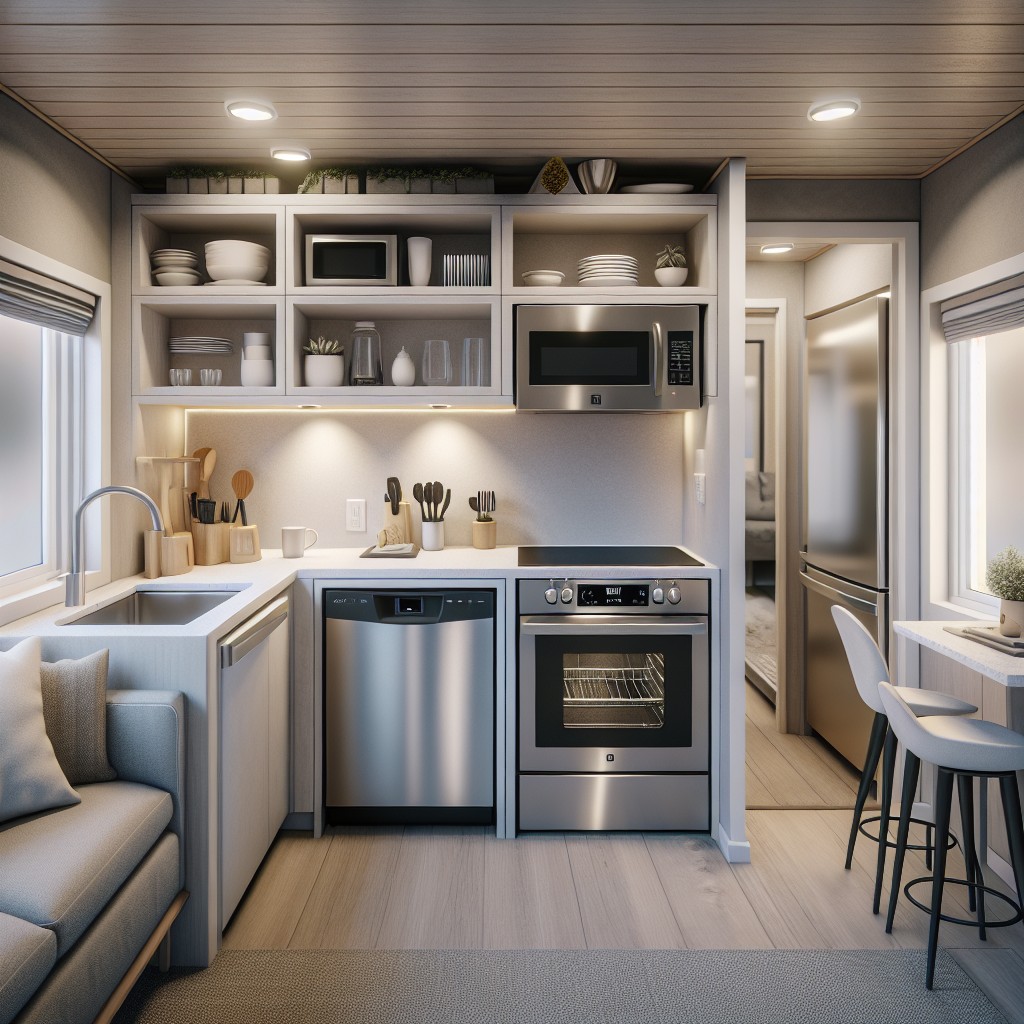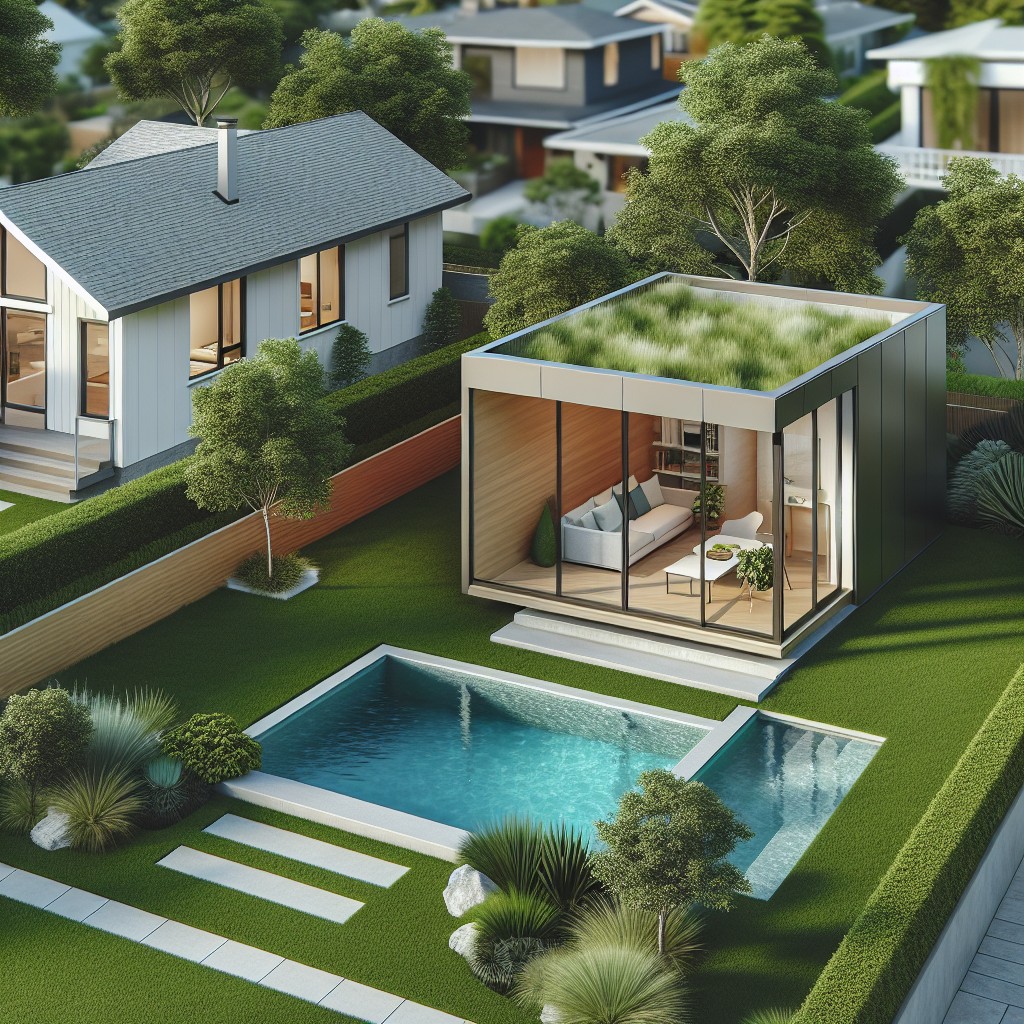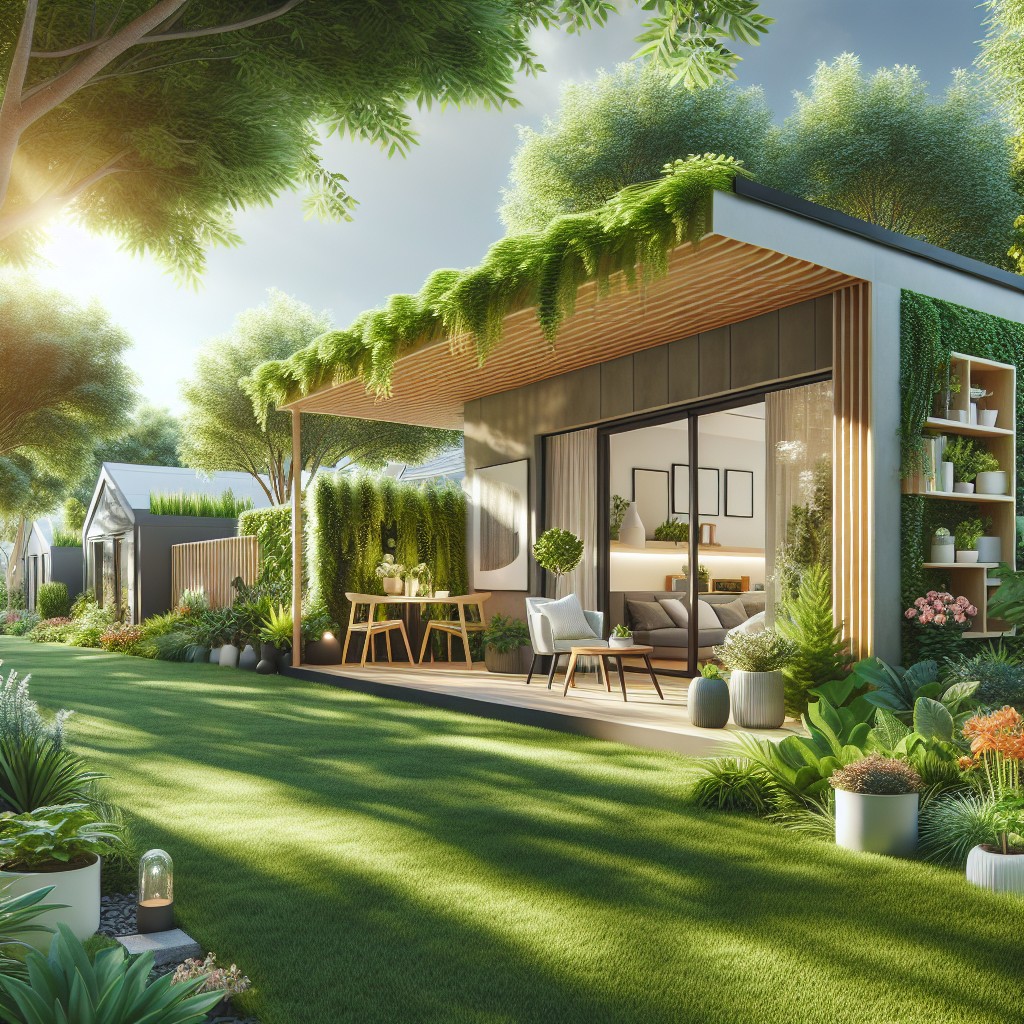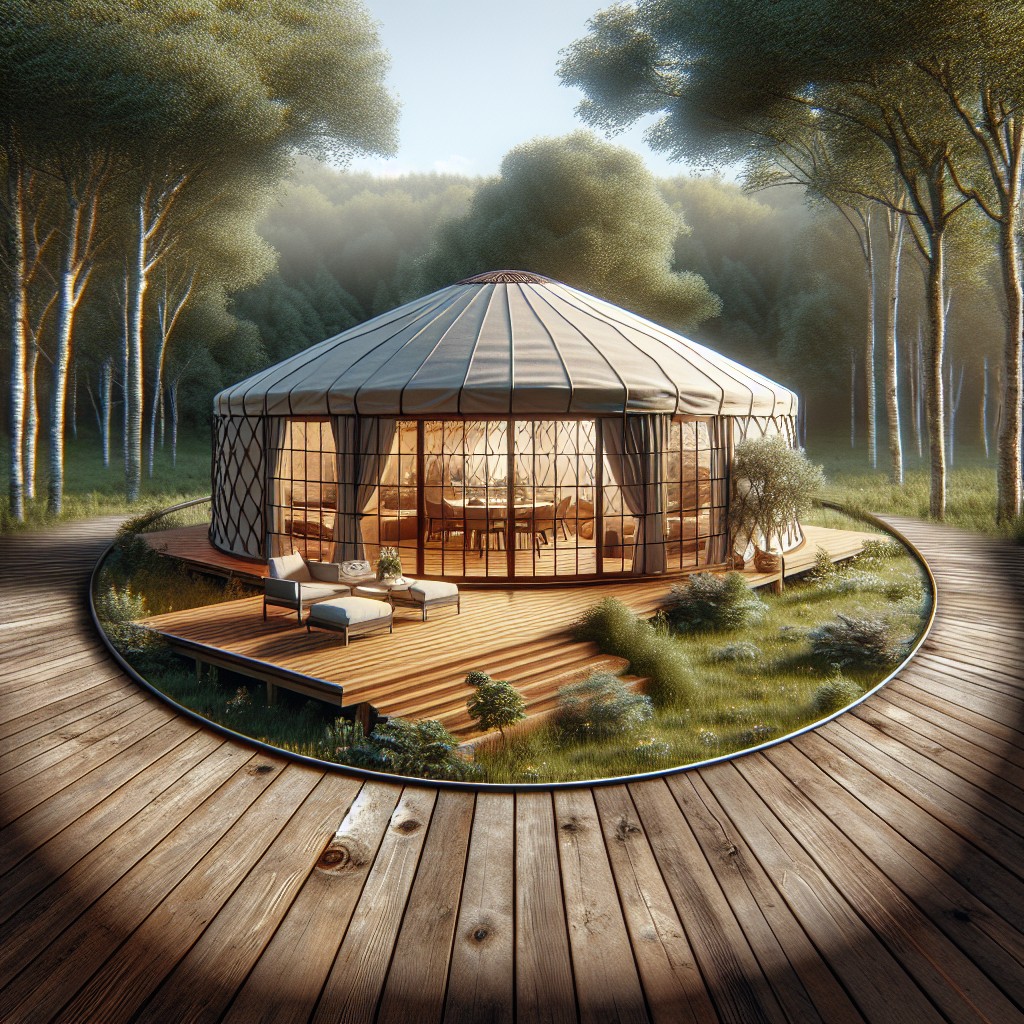Last updated on
Yes, an accessory dwelling unit (ADU) typically requires a kitchen as per the technical considerations of most residential codes.
Absolutely, an Accessory Dwelling Unit (ADU) does require a kitchen space. This is largely due to the definition of an ADU as a compact, self-contained residential unit that’s an auxiliary to the main dwelling. Basic requirements for an ADU typically include a kitchen, bathroom, and sleeping area.
Not only does this make the ADU a fully functional living space, but it also enhances its potential for rental income or family use. As we delve further into the topic, we’ll explore some unique kitchen designs and considerations that make the most of your ADU’s limited space, keeping sustainability at its best.
Key takeaways:
- An ADU typically requires a kitchen according to most residential codes.
- Kitchen requirements for an ADU include cooking appliances, a refrigerator, sink, countertops, and storage.
- ADUs can have detached, garage conversion, attached, or interior conversion designs.
- ADUs can increase property value and provide additional income.
- Local zoning laws and building codes determine the legality and design requirements of ADUs.
ADU Kitchen Requirements

Accessory Dwelling Units (ADUs) typically include a range of amenities to ensure they’re fully functional for living, mirroring the utilities of a primary residence. One of the quintessential features is the kitchen, but does a kitchen always have to be part of an ADU?
The short answer is it depends on local regulations. Most jurisdictions consider a kitchen a necessary component for an ADU to be a legally rentable and livable space. This ensures residents have the ability to cook and prepare meals, which is a basic living requirement. The kitchen should include a cooking appliance, such as a range or cooktop, a refrigerator, and a sink.
Cabinetry and countertop spaces are also expected, to make the space convenient for meal prep and storage. You might find variations in requirements on the minimum size or the types of appliances needed. For instance, some areas might allow for compact appliances, like under-counter fridges or two-burner stovetops, to conserve space.
When planning to build or convert an area into an ADU, always refer to your local building codes and zoning ordinances. They will provide the specific guidelines you need to follow for your ADU project to ensure it meets all the legal requirements.
Characteristics of an ADU
Accessory Dwelling Units (ADUs) are independent living spaces that supplement the primary residence on a property. While configurations may vary, standard characteristics typically include:
- Separate Entry: Most ADUs boast their own entrances, ensuring privacy for both the main household and ADU occupants.
- Living Space: They include a dedicated living area, which can range from a studio layout to a full multi-room floor plan.
- Bathroom Facilities: ADUs come equipped with at least one bathroom to provide complete living functions for the inhabitants.
- Utility Connections: These units often share the main home’s utilities but may also have separate meters for electricity and water to facilitate independent billing.
- Size Restrictions: They are generally smaller than the primary dwelling and must adhere to local zoning laws related to size and placement.
- Design Standards: The design can reflect the main house’s aesthetics or be completely distinct, yet they must meet the building codes and regulations set by the jurisdiction.
ADUs represent a blend of autonomy and inclusivity, optimizing the usable space within residential lots and providing versatile housing solutions.
What Is Considered an Accessory Unit?
Defined as a secondary housing unit on a single-family residential lot, an accessory dwelling unit (ADU) serves as an independent living space and typically offers the basic amenities found in a primary dwelling.
These additional units come in various forms – from converted garages and basements to standalone structures or attached additions.
Regardless of type, ADUs generally include sleeping, cooking, and bathroom facilities, making them fully functional living spaces that can accommodate tenants, family members, or guests.
Their design and layout must adhere to local zoning and building laws, which dictate size, placement, and utility connections, ensuring they integrate seamlessly with the primary residence and neighborhood.
The Standard Kitchen
To fulfill the kitchen requirement, an ADU typically must include several key features which typically constitute a standard kitchen setup. These include:
- Cooking Appliances: A stove or cooktop, along with an oven, allows occupants to prepare a wide array of meals. Some jurisdictions may allow alternatives, such as a microwave or hotplate, for smaller ADU designs.
- Refrigeration: A full-size or compact refrigerator is essential for storing perishable goods safely.
- Sink and Faucet: A kitchen sink with running hot and cold water is necessary for food preparation and cleaning chores.
- Countertops and Storage: Adequate counter space for food prep and cabinets for storing dishes, cooking utensils, and pantry items support day-to-day living needs.
- Electrical Outlets: Sufficient outlets must be available to power kitchen appliances safely.
These elements ensure that an ADU offers comparable livability to a standard home, allowing residents to comfortably perform daily routines such as cooking and cleaning. Keep in mind, local building codes may have specific requirements concerning the size and layout of these features, so it’s important to consult your local zoning ordinances.
Eligibility for Sale to Freddie Mac
For an ADU to contribute towards a home’s value and loan qualification, certain criteria must be met for it to be recognized by Freddie Mac, a government-sponsored enterprise that buys mortgages from lenders to keep money flowing in the housing market.
Here are some pivotal points for understanding this process:
- Separate and Self-Sufficient: The unit must be a separate, self-sufficient dwelling with its own entrance, bathroom, and kitchen facilities to qualify as a livable space.
- Compliance with Local Zoning: The ADU has to adhere to local zoning and building codes. It’s crucial to ensure the unit is legally permitted as this affects mortgage eligibility.
- Livability and Accessibility Standards: Freddie Mac requires that ADUs meet specific standards for safety, habitability, and accessibility to be considered in the value and loan qualification of the property.
- Mortgage Documentation: Lenders need to document ADUs as part of the collateral for the loan, and include the income generated from the unit, if any, to qualify for sale to Freddie Mac.
- Appraisal Requirements: A licensed appraiser must include the ADU in the property appraisal report, analyzing its impact on the property’s market value and marketability.
- Rental Income: If rental income from the ADU is used to qualify for a mortgage, lenders must have evidence of the income’s stability and likelihood of continuance.
Understanding and meeting these requirements is critical for leveraging an ADU in your mortgage considerations with Freddie Mac.
ADU Rental Income Used to Qualify the Borrower
Lenders may consider potential rental income from an ADU when assessing a borrower’s ability to repay a mortgage. This inclusion can bolster the borrower’s qualifying income, potentially facilitating a larger loan or better terms.
When applying for a mortgage, borrowers should inform lenders that they intend to rent out the ADU.
Documentation, such as a signed lease agreement, may be required to verify the rental income.
Some lenders may require a history of rental income, while others might accept projected rents based on fair market values.
The amount of rental income recognized can vary by lender, with some considering a percentage of the total rent to account for vacancy and maintenance costs.
Income from an ADU could also impact the borrower’s debt-to-income ratio, a critical factor in loan qualification.
These points illustrate the financial benefits an ADU can provide, serving as both a home improvement and a potential income generator to assist homeowners with their mortgage responsibilities.
Types Of ADUs In Real Estate
Understanding the diverse options available can greatly inform your decision-making when considering the addition of an accessory dwelling unit to your property.
Detached ADU: These standalone structures offer maximum privacy as they are completely separate from the main residence. Ideal for homeowners with ample backyard space, detached ADUs often function as independent living quarters, complete with their own entrances and amenities.
Garage Conversion: An economical and space-efficient choice, converting an existing garage into an ADU can be a clever way to utilize unused space. This type usually involves retrofitting the garage to make it habitable, adding features such as insulation, windows, and sometimes raising the floor to meet residential standards.
Attached ADU: Sharing a wall with the primary dwelling, attached ADUs are an extension of the existing home. They are suitable for those looking to maintain a degree of connection with the ADU occupants while still providing a separate living space.
Interior Conversion: Sometimes referred to as a “junior ADU,” this type involves sectioning off a part of the main house, like a basement or a large room, and outfitting it with independent living facilities. It’s typically the most cost-effective type, as it utilizes the existing structure and systems of the home.
Detached ADU
A detached ADU is a standalone structure situated on the same property as the main residence. Imagine a cozy cottage or a studio tucked away in the backyard, offering a completely separate living space.
Here are key points to consider about this type of ADU:
- Privacy: Detached ADUs offer tenants or family members maximum privacy due to their physical separation from the main home.
- Flexibility in Use: These units can serve various purposes, such as rental income property, a home office, or a space for guests or multigenerational families.
- Design Freedom: You have the liberty to design the exterior and interior without the constraints of integrating with an existing structure.
- Potential for higher rental income: Since they are entirely separate, detached ADUs can command higher rents compared to attached or internal ADUs.
- Zoning and Setbacks: They often require adherence to specific zoning laws, including setbacks from property lines and height restrictions.
- Construction Considerations: Building a detached ADU may involve more extensive construction, permitting, and potentially higher costs, as they require their own utility connections and might entail landscaping changes.
Garage Conversion
Transforming a garage into an ADU is a clever way to repurpose existing space, especially for homeowners lacking additional land for construction. Here are key points to consider:
- Zoning Regulations: Check local zoning laws to ensure conversions are permitted and identify what permits and inspections are required.
- Structural Integrity: Have the existing garage structure assessed by a professional to guarantee it can support the conversion and additional living space requirements.
- Utility Connections: Plan for extending electrical, plumbing, and heating services from the main house to the garage, maintaining adherence to building codes.
- Design Considerations: Optimize the layout to include essential living spaces within the limited footprint, such as a compact kitchen, bathroom, and living/sleeping area.
- Insulation and Ventilation: Upgrade insulation to meet residential standards and ensure adequate ventilation for a comfortable and healthy living environment.
- Privacy and Access: Establish private access for occupants and consider soundproofing to maintain privacy between the ADU and the primary residence.
- Parking Solutions: Address any displacement of parking by converting the garage, which might involve creating new parking spaces to comply with local requirements.
Approaching a garage conversion with these points in mind will facilitate a smooth transition from a simple storage area to a functional and self-contained living unit.
Attached ADU
An attached ADU, also known as an attached accessory dwelling unit, is a secondary housing unit constructed as an integral part of the existing main residence. It shares at least one wall with the primary home and typically has its own entrance, living space, bedroom, and bathroom.
Here are some key points to understand about this type of ADU:
- Integration: These units are designed to blend with the main house’s architecture, providing seamless aesthetic continuity.
- Cost-Effectiveness: Since they share resources with the main structure – like walls and roofing – they can be more cost-efficient to build compared to detached units.
- Zoning Regulations: You’ll need to check local zoning laws, as some areas may have restrictions on the size and design of attached ADUs.
- Privacy Considerations: Although attached, plans often feature soundproofing and separate outdoor spaces to create a sense of privacy for both the occupants of the ADU and the main residence.
- Potential Usage: They are ideal for renters, in-laws, or as a remote workspace, offering the convenience of proximity to the main home while maintaining independence.
Remember, the specific requirements for constructing an attached ADU can vary greatly depending on local ordinances, so it’s crucial to consult with planning authorities early in the design process.
Interior Conversion
Transforming existing space within a primary residence into an independent living area defines an interior conversion for an ADU. This approach may encompass converting basements, attics, or spare rooms.
Key factors to consider in this conversion include:
- Ensuring separate entryways to promote privacy and independence.
- Soundproofing shared walls to minimize noise disruption.
- Verifying ceiling heights meet legal requirements, particularly in basements and attics.
- Planning for sufficient natural light and ventilation, potentially through egress windows.
- Upgrading utility services, such as water and electric, to accommodate the additional usage.
- Upgrading HVAC systems to ensure consistent and efficient climate control for both living areas.
- Considering the impact on the primary living space, especially in terms of lost space or access to common areas.
Interior conversions often present a cost-effective way to create an ADU since they utilize the existing footprint of the home. However, adhering to local building codes and obtaining the necessary permits is critical before beginning any construction or renovation project.
Why Add An Accessory Dwelling Unit?
Adding an accessory dwelling unit (ADU) to your property has numerous advantages that cater to different needs and goals. For homeowners seeking additional income, renting out an ADU can provide a steady cash flow. Families may find ADUs ideal for multigenerational living, offering a blend of proximity and privacy for relatives or even a separate space for grown children saving for their own homes.
Space efficiency is another compelling reason to build an ADU. It maximizes the utility of your property, especially in urban areas where land is at a premium. ADUs can also serve as a dedicated area for remote work or hobbies, thus fostering work-life balance.
Environmentally conscious homeowners appreciate ADUs for their potential to reduce ecological footprints. Smaller spaces are inherently more energy-efficient, and ADUs often employ green building practices and technologies.
Lastly, amidst housing shortages in many cities, adding an ADU contributes to the availability of more affordable housing options within the community, supporting economic diversity and inclusion.
Accessory Dwelling Unit Pros And Cons
Pros:
- Additional Income: Renting out an ADU can provide homeowners with a steady source of additional income.
- Increases Property Value: Homes with an ADU often have higher market values due to their increased versatility and potential for revenue.
- Flexible Use: ADUs can be used as housing for family members, a home office, or a guest house, providing flexibility for changing lifestyle needs.
- Affordable Housing: ADUs offer a more affordable housing option in areas where rent is typically high, benefiting both homeowners and tenants.
- Aging in Place: Seniors can use ADUs to downsize while staying on their property, or they can live in the main house with caretakers in the ADU.
Cons:
- Upfront Costs: Building an ADU involves significant initial expenses, including construction costs, permitting fees, and potential utility upgrades.
- Increased Responsibility: Being a landlord comes with responsibilities, such as maintenance, repairs, and managing tenant relationships.
- Potential for Conflict: Close quarters can lead to privacy issues or disputes between tenants and homeowners.
- Zoning Restrictions: Local zoning laws may impose limitations on the size and style of ADUs, as well as restrict their use.
- Insurance and Taxes: Homeowners may face higher property taxes and need additional insurance coverage for their ADUs.
Pros
Understandably, adding an accessory dwelling unit to your property can offer a myriad of benefits. Here are a few:
Additional Income Source: Renting out your ADU can provide a steady stream of extra income, potentially easing mortgage pressure or funding property improvements.
Increased Property Value: ADUs can substantially raise your property’s market value, making it a profitable long-term investment.
Flexible Use: These units serve various purposes: a home for aging relatives, a private space for guests, or even as a separate home office.
Housing for Loved Ones: They offer a viable solution for multi-generational living, keeping family close while maintaining privacy.
Community Benefits: By increasing the local housing stock, ADUs help to alleviate housing shortages in urban areas without altering neighborhood character.
Eco-Friendly: Smaller living spaces typically consume less energy, promoting sustainable living practices and reducing the carbon footprint.
Each of these advantages contributes to the growing appeal of accessory dwelling units as smart additions to modern homes.
Cons
While ADUs offer many benefits, they can also come with downsides that homeowners should consider before embarking on a construction project. Cost is a key concern, as building an ADU requires a significant financial investment, with expenses ranging from permits and design to construction and ongoing maintenance. Moreover, there can be insurance implications, as homeowners may face increased premiums to cover the additional structure.
Local zoning regulations might also impose restrictions on size, style, and rental possibilities, potentially limiting the unit’s functionality or profitability. Privacy can become an issue too, particularly for attached units, potentially affecting both the main residence and the ADU occupants.
Furthermore, the process can be time-consuming, often involving a lengthy permit process and potential delays during construction. Homeowners must also be prepared to take on the role of a landlord if they choose to rent out the unit, which includes finding and managing tenants, understanding tenant-landlord laws, and dealing with any disputes that may arise.
Are ADUs Legally Permitted?
Accessory Dwelling Units (ADUs) garner attention as a solution for housing shortages and multigenerational living arrangements. Whether these units are legally permitted depends on local zoning regulations that vary from place to place.
Local Zoning Laws: To determine if you can build or have an ADU, consult the specific zoning regulations of your city or county. These local ordinances define what’s permissible on your property.
Permitting Process: If ADUs are allowed, homeowners must navigate a permitting process that typically involves submitting detailed plans and obtaining approval from the local planning department.
Recent Trends: Many regions have been adjusting their zoning laws to be more ADU-friendly in response to housing needs, so staying abreast of the latest ordinances in your area is crucial.
Restrictions and Requirements: Even in areas where ADUs are permitted, there may be restrictions on size, placement, and occupancy, as well as requirements like providing off-street parking.
Code Compliance: All ADUs must comply with building codes, which ensures that the structure is safe for occupants. This includes meeting standards for egress, fire safety, and structural integrity.
HOA Rules: If your residence is governed by a Homeowners Association (HOA), you’ll also need to check if there are any covenants or restrictions placed on ADUs.
In summary, the legality of ADUs is contingent upon navigating a web of local zoning laws, building codes, and sometimes HOA regulations, which requires due diligence on the part of homeowners. Checking with local planning departments can provide clarification and the latest up-to-date information.
Will Adding an ADU Increase My Home’s Value?
Adding an Accessory Dwelling Unit (ADU) may positively impact property value by increasing its market appeal and functionality.
Potential buyers often see ADUs as a source of rental income, which can offset mortgage costs or provide a separate living space for extended family.
This versatility is attractive in diverse housing markets.
Moreover, properties with ADUs may command a premium due to their additional livable square footage and potential for multigenerational living arrangements.
However, the exact impact on home value can vary depending on local real estate trends, the quality of the ADU construction, and how it integrates with the existing property.
It’s advisable for homeowners to consult with local real estate professionals to assess the potential value increase specific to their area and property.
How Does an ADU Access Utilities?
Accessory dwelling units tap into utility services in a couple of ways. They can connect to the existing primary residence’s utility connections, which can be more cost-effective as it avoids installing separate meters for services like water, gas, and electricity. The alternative involves setting up independent connections for the ADU, which could be mandatory in some jurisdictions and offers the advantage of separate billing. This is especially useful if the unit is intended for rental purposes.
Connecting an ADU to sewer lines typically requires compliance with local codes, including possible impact fees and permits. Electrical systems may need an upgraded service panel to handle the additional load. For internet and cable services, wireless connections make it easier to extend coverage from the main house without extensive wiring. Always consult with local building officials to ensure your utility setup adheres to all regulations and consider engaging a licensed contractor to navigate technical aspects and ensure a safe installation.
FAQ
What constitutes a kitchen in an ADU?
A kitchen in an ADU (Accessory Dwelling Unit) constitutes permanent facilities for cooking, which should be provided within the unit itself if it does not share kitchen facilities with the primary dwelling.
What’s one drawback of an ADU?
One drawback of an Accessory Dwelling Unit (ADU) is its limited living space, which can make it feel cramped especially for large families or those requiring ample space.
What are the rules for ADU in Washington state?
In Washington state, the rules for Accessory Dwelling Units (ADUs) dictate that they must be permitted to be attached, detached, or a combination of both, existing structures can be converted into ADUs, and they should not be required to be smaller than 1,000 gross square feet in size.
How does adding an ADU impact property taxes?
Adding an Accessory Dwelling Unit (ADU) typically increases property taxes as it usually raises the overall value of a property.
Are there specific environmental sustainability standards for ADUs?
Yes, there are specific environmental sustainability standards for ADUs, often mandated at the local level, such as energy efficiency, use of sustainable materials, and reduced environmental footprint.
What are the energy-efficient appliances suitable for an ADU kitchen?
Energy-efficient appliances suitable for an Accessory Dwelling Unit (ADU) kitchen include an ENERGY STAR-rated refrigerator, dishwasher, and induction cooker.
Related reading:
Table of Contents





